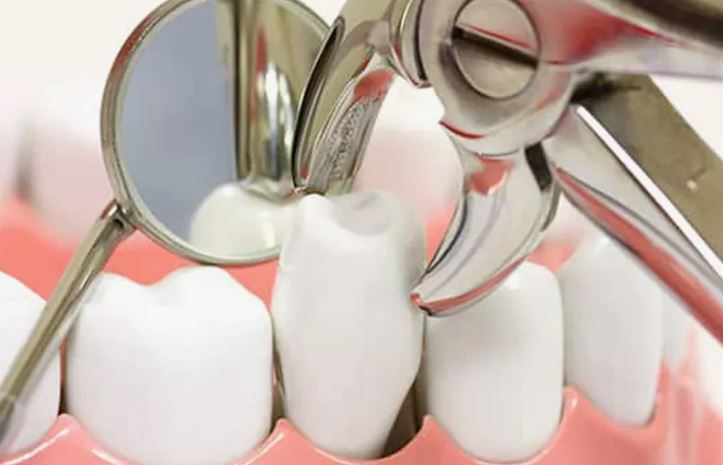Dental Extraction: A Comprehensive Guide to Understanding the Process and Risks

Dental Extraction: A Comprehensive Guide to Understanding the Process and Risks
Have you ever considered what transpires during tooth extraction? It’s possible that you need a dental extraction yourself or you’re just interested in learning more about it. In either case, you’re at the right spot! Knowledge is our key to patient empowerment here at Ramlaoui D.D.S. Let us now explore the realm of dental extractions and provide you with all the information you require.
ALT Text: Dental Extraction
What is Dental Extraction, and Why Might You Need One?
Dental extraction is simply a tooth’s removal from the jawbone. At Ramlaoui D.D.S., maintaining your natural teeth is always our top priority; however, occasionally, extractions are required. Listed below are some of the causes:
- Severe tooth decay or damage
- Advanced gum disease
- Overcrowding in the mouth
- Impacted wisdom teeth
- Preparation for orthodontic treatment
It’s essential to comprehend dental extraction procedures and associated hazards in order to make well-informed judgments regarding your oral health. So, let’s break it down step by step.
Types of Dental Extractions: Simple vs. Surgical
There are differences between dental extractions. One of two extraction procedures could be performed, depending on the state and location of the tooth:
- Simple Extraction
- Performed on visible teeth
- Usually done under local anesthesia
- Involves loosening the tooth and removing it with forceps
- Surgical Extraction
- Required for teeth that are not easily accessible
- May involve removing surrounding bone or cutting the tooth
- Often necessary for:
- Impacted wisdom teeth
- Broken teeth below the gumline
- Severely decayed teeth
Ramlaoui D.D.S. evaluates each case for the best extraction method.
The Dental Extraction Process: What to Expect
Pre-procedure Preparation
We conduct an extensive preparation procedure before beginning any extraction:
- Comprehensive Dental Examination: X-rays will be taken to provide a clear image of the tooth’s position and root structure while we examine your tooth and the surrounding area.
- Medical History Review: Your health and medications may affect the surgery and recuperation, so please let us know about them.
- Anesthesia Discussion: Depending on the difficulty of the extraction and your comfort level, we’ll go over your anesthetic options, which could include local anesthetic, sedation, or general anesthesia.
The Extraction Procedure
On the day of your extraction:
- We’ll administer the agreed-upon anesthesia to ensure your comfort throughout the procedure.
- Lifting the tooth with an elevator and extracting it with forceps is the classic extraction procedure.
- For a surgical extraction, we might cut your gum and remove some bone to reach the tooth.
- After removing the tooth, we’ll clean the socket and stitch if needed.
- At the extraction site, gauze will be used to halt bleeding and aid in clotting.
Understanding the Risks and Complications
Dental extractions are common, but be mindful of possible risks.
- Bleeding: Bleeding for a day following the extraction is typical.
- Infection: Infections can occasionally occur at the extraction site due to bacteria.
- Dry Socket: Pain happens when the blood clot at the extraction site moves or disappears.
- Nerve Damage: Extractions can occasionally result in either temporary or permanent nerve injury.
- Sinus Complications: Upper tooth removal can occasionally create a sinus cavity hole.
- Delayed Healing: Things like smoking or not cleaning your teeth well can make healing slower.
Our goal at Ramlaoui D.D.S. is to lower risks and provide painless extractions.
Managing Recovery and Aftercare: Your Path to Healing
Taking good care after the procedure is key for fast healing. How should you proceed:
- Pain Management: Follow the directions on prescription or over-the-counter pain medicines.
- Control Bleeding: Bite down gently on gauze pads to reduce bleeding. Replace them as needed.
- Prevent Infection: 24 hours after the extraction, rinse with warm salt water. Keep your teeth clean and abstain from smoking.
- Dietary Recommendations: Eat soft foods for some days. Don’t have hot drinks or use straws, as they can move the blood clots.
- Gradual Return to Normal Activities: Rest on day one, then gradually return to routine as comfortable.
Replacing Extracted Teeth: Restoring Your Smile
Post-healing, consider tooth replacement for oral health and smile aesthetics. At Ramlaoui D.D.S., we have a few choices for you:
- Dental Implants: Roots of artificial teeth supporting dentures
- Bridges: Items that are fixed and fill the space left by missing teeth
- Partial Dentures: Tools that you can remove to replace multiple lost teeth
We’ll collaborate with you to choose the ideal replacement choice based on your unique requirements and preferences.
Your Dental Health is Our Priority
Dental extractions are not to be feared if you are in competent hands, even though they are occasionally necessary. At Ramlaoui D.D.S., we provide skilled care together with sympathetic attention to make sure you’re comfortable at all times.
Recall that the state of your mouth affects your general health. By identifying problems early, routine dental checkups can frequently avoid the need for extractions. So make your next dentist appointment right now rather than waiting till you’re in pain!
Ready to take control of your oral health? Visit www.ramlaoui.com to learn more about our services or to schedule a consultation. Together, let’s maintain the health and brightness of your smile!
27-06-2024

